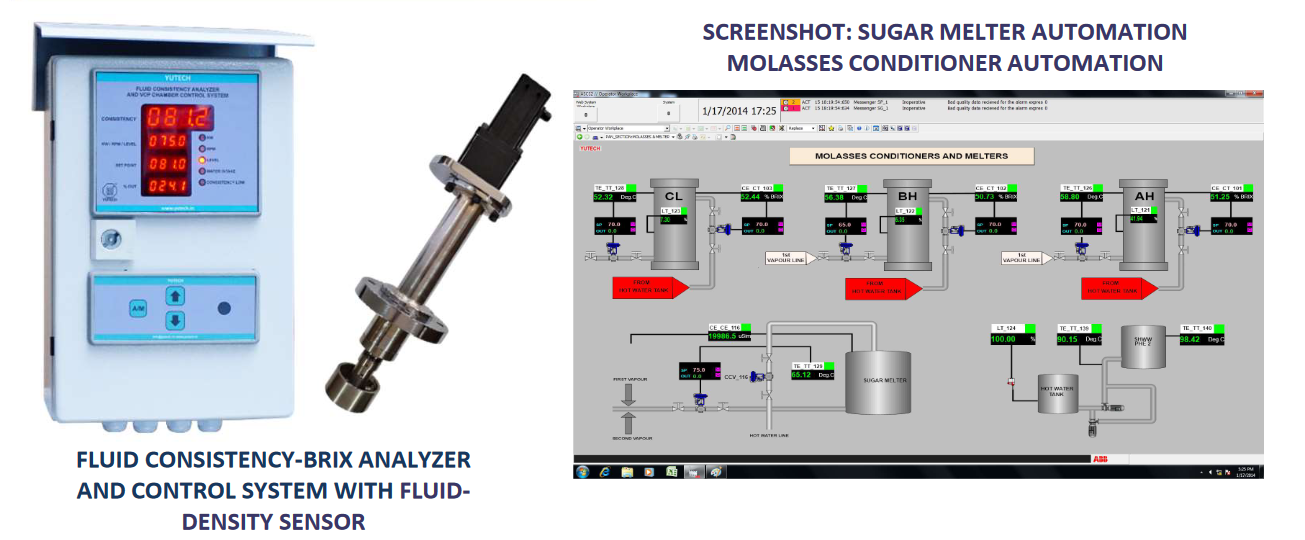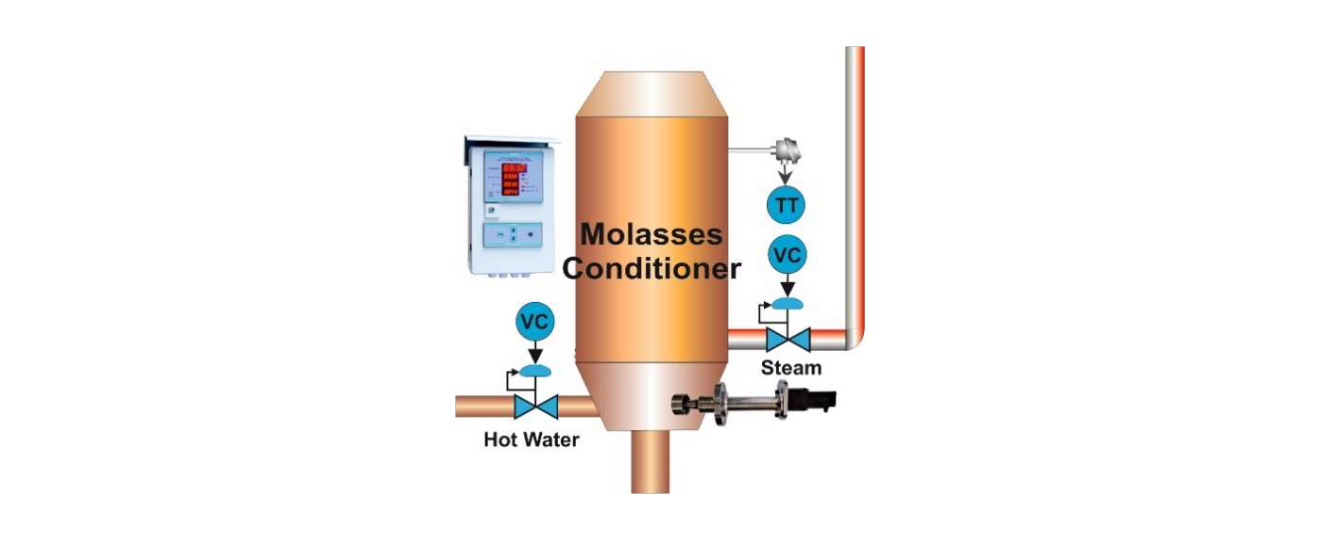MOLASSES CONDITIONER AUTOMATION WITH BRIX ANALYZER AND DENSITY BRIX SENSOR

Molasses Conditioner Automation Advantages:
- Streamlined Process Due To Constant And Maintained Outlet Brix And Temperature.
- Ensure Constant Quality Of Molasses Feed To Pans.
- Reduce Heat Waste, Due To Overheating Or Under Dilution Or Over Steaming.
- Reduce Process Time By Avoiding Extra Dilution
- Thus Save Time, Steam, And Water And Ensure More Throughput In Less Time.
- Increase Profitability
Control Loops:
- Controlled Intake Of Heating Media (Steam), And Diluting Media (Water) As Per Process Dynamics Like Brix And Temperature Of The Molasses Intake.
Brix Control using Brix or Fluid-Density-Brix
Analyzer:
- Brix Of Molasses Are Maintained By The Controlled Addition Of Hot Water To Molasses Using A Hot Water Control Valve In A Pid Loop. Value Of Molasses Fluid-Density-Brix / Brix Sensed By A Fluid-Density-Brix Analyzer Or High-Frequency Brix Analyzer Is Used As The Process Variable For This Pid Action..
Temperature Control:
- Molasses Temperature Is Maintained Constant By Controlled Application Of Steam Using A Control Valve In A Pid Loop Using Molasses Temperature Value As The Process Variable For Pid Action.

Fluid Density Brix Analyzer Technical Specifications:
Product Code: A15FDACFM1230 / A24FDACFMEM1230
- Power Supply: 85 - 265 VAC, 50 - 60HZ
-
Inputs:
- Fluid-Density Sensor
- RTD PT100 Temperature Sensor
- 8-Point Level Sensors (Conductivity-Based Digital Switch Type)
- 4-20MA: Input From Vacuum Transmitter (Optional, Not A Part Of Standard Supply)
- 4-20Ma: Input From Differential Pressure Transmitter With Extended Diaphragm With Capillary Tubes (Optional, Not A Part Of Standard Supply)
-
Outputs:
- 4-20Ma: Brix Output
- 4-20MA: PID Output For Brix Control (Brix As Pv For Pid Control)
- 2 Potential-Free Relay Outputs
-
Display:
- For Product Code - A15FDACFM1230: 7-SEGMENT LED DISPLAY
- For Product Code - A24FDACFMEM1230: 7-SEGMENT LED DISPLAY AND LCD DISPLAY
- Enclosure: Field Mounted Ms Powder Coated, Ingress Protection Class Ip67
-
Communication:
- Ethernet: Modbus Tcpip (Product Code: A24FDACFMEM1230)
Fluid Density Sensor Technical Specifications:
Product Code: A24FDSRS1, A24FDSRS2, A24FDSRS3
- Type: Motorized Fluid Density Sensor
- Power Supply: 24VDC From The Analyzer (Not To Be Connected To Any External Source).
- Enclosure: Field Mounted Ms Powder Coated, Ingress Protection Class Ip67
-
Built-In Thermowell With RTD PT100
- Material Of Construction: SS304 / SS316L
- PTFE Sheathed Conductivity Probe 8 Nos.: SS304 / SS316L With PTFE Sheath
-
Material Of Construction:
- For Food-Grade, SS-304 Full Sensor Body: Add Fgss To The Pc. EX: A24FDSRS3FGSS
- Wetted Stationary Parts: MS Chrome Plated / SS304 / SS316L
- For Food-Grade, SS-304 Full Sensor Body: Add FGSS To The PC. Ex: A24FDSRS3FGSS
- For Acidic Chemicals, SS-316L Full Sensor Body: Add SSL To The Pc. Ex: A24FDSRS3SSL
Fluid Density Sensor Model Guidance For Various Applications:
A24FDSRS1: Batch Pan, Horizontal Continuous Pan, Vertical Continuous Pan
A24FDSRS2: Evaporator, Falling Film Evaporator, Juice And Syrup Mixing Vessel
A24FDSRS3: Sugar Melt, Molasses Conditioner, Lime Baume
A24FDSRS3FGSS: Breweries, Food & Beverages, Dairy
A24FDSRS3FGSSL: Chemicals, Distillery Slope / Spentwash




